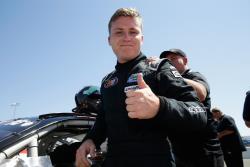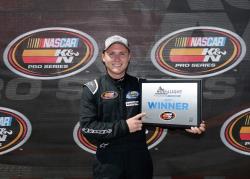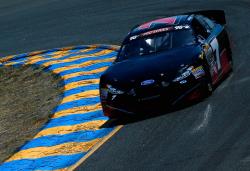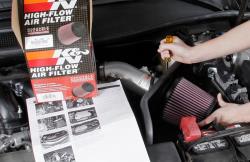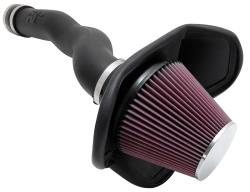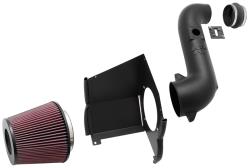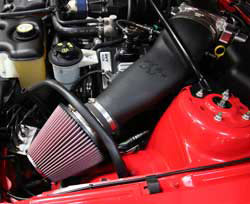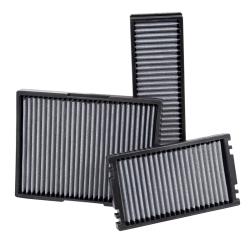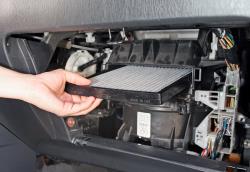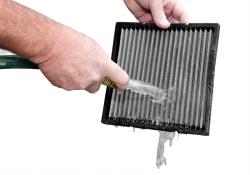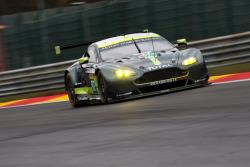
The #97 Aston Martin Vantage GTE was within range of the leaders throughout the event | The team of Darren Turner, Daniel Serra, and Jonny Adam had driven hard to keep their Aston Martin Vantage GTE within striking distance of the Chevrolet Corvette against which they’d been competing for over 23 hours. It was a difficult challenge for the Aston Martin trio as their car was based on a much older model than the Ford GT or Corvette. Next year there’d be a brand-new design but right now they had to fight with what they had.This was the 85th running of the 24 Hours of Le Mans, named for the city just north of the Circuit de la Sarthe, where the race is held. The first event was run in 1923 and it’s been run annually except for 1936 as there was a workers strike in France, and then from 1940 through 1948, due to WWII. The circuit was originally comprised entirely of public roads. The bulk of the circuit remains so for the rest of the year. The famed Mulsanne Straight, a standard highway when not used for the race at one time measured 3.7 miles long and by 1988 cars could achieve up to 240 mph. For safety, there are now two chicanes dividing the Mulsanne into three shorter straightaways. 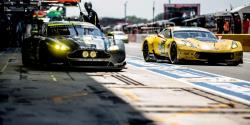
Jonny Adam slips in behind the Corvette of Ricky Taylor leaving the pits for the final dash | With the leading Corvette in sight and the Ford GTs right on their tail, Aston Martin Racing made the decision that the final stop for car #97 would be fuel only – no fresh tires, no replacement driver – trying to save as much time as possible to get Jonny close to the Corvette in the closing minutes of the race. The strategy paid off as Jonny exited the pits on the tail of the leading Corvette C7R.“We nearly got the jump on the Corvette at the stop, but we had to pull in behind it and trundle down the pit lane,” recalls Adam. "Then my engineer came on the radio and said ‘to win Le Mans, you have to pass that Corvette.’" 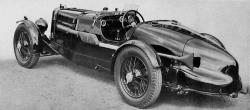
The 1.5L Aston Martin Ulster was a popular car and frequent class winner at Le Mans in the 1930s | Aston Martin is no novice at Le Mans. It first competed in 1931 with its sophisticated 1.5L engine the top entry finished fifth overall, besting much larger cars. Though there were entries each year the race was run, the factory didn’t get serious until 1950, when it created an all-new sports car capable of tackling the event. That was the DB2 which was further developed into the DB3 (and later the DB5, for which James Bond had a affinity).By 1959, Aston Martin constructed a full-on race car -- the DBR1/300, with a 3.0L six cylinder engine. With it, factory drivers Carroll Shelby and Roy Salvadori won the 1959 24 Hours of Le Mans outright against six factory Ferraris driven by the likes of fellow Americans Dan Gurney and Phil Hill. Aston Martin withdrew from motorsports, and while providing encouragement from time to time to private teams, supported no official entry. In 2004, the creation of Aston Martin Racing and the marque’s full-scale return to international motorsports came to fruition. 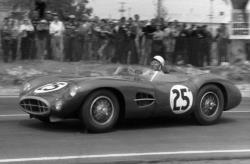
Carroll Shelby co-drove an Aston Martin DBR1 to overall victory in the 1959 24 Hours of Le Mans | The team's first race was the opening round of the American Le Mans Series at Sebring in 2005, where it scored a spectacular GT1 class victory with a DBR9, despite limited testing. Darren Turner, one of the three drivers who piloted the winning Aston Martin at Le Mans this year was also on the victorious squad at that first Sebring race. In 2007, Aston Martin took its first class victory at Le Mans for the DBR9.“We started the partnership back in 2005 with the Aston Martin DBR9,” explained Joost Adriaans who is the K&N R&D Manager for Europe, Middle East, and Africa. “In 2013, we transitioned from supplier to partner, so we now have K&N branding on the race cars, pit panels, and support trucks. We also supply Aston Martin with K&N Filters for the Vantage V8 GTE, GT3, and GT4 cars,” Joost added. In 2014, Aston Martin scored another Le Mans win for the Vantage GTE. And now the K&N-equipped #97 Aston Martin Vantage GTE was headed down the pit lane on the heels of the #63 Corvette driven by American Jordan Taylor, whose car was full of fuel but also without fresh tires. 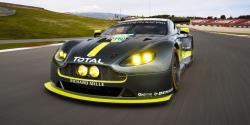
Despite being based on a much older platform, the Vantage GTE performed well against the Corvette | As he followed Taylor around the track for several laps Jonny analyzed the young American’s strengths and weaknesses. “The one area I thought he looked weak on was the run to Indianapolis and down to Arnage,” Jonny related. Based on his observations he took a shot at passing Taylor at the Arnage right-hander but couldn’t make it stick. Jonny remained within 1.5 seconds of Taylor as they rounded the 8.47 mile circuit. Then on the second to last lap Taylor locked up the brakes on the Corvette at the second Mulsanne chicane. "There was a small bit of contact on the way out of the (Arnage) corner and again the gap rose, but he had a big lock-up down the Mulsanne, into the second chicane, and then after that he was braking a lot earlier in some places," Jonny recalled. "We were running nose-to-tail through the Porsche Curves, I could see his left-front tire seem to start delaminating, and the key then was to be patient, wait until the exit, and get him there.” 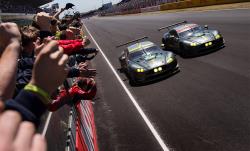
The winning Aston Martin crosses the finish line alongside a team car a few laps down | Taylor said the high-speed lock-up at the chicane took him by surprise, and afterwards he was battling a flat spot on one tire while another was deflating. "When the lock-up happened it was so abrupt and unexpected -- usually you lock in the second part of the brake phase, but these just locked as soon as I touched the brake, so it caught me off-guard," Taylor said. "When I knew I wasn't going to make the chicane I decided just to go straight, try to make the most of it, so I went flat-out through the gravel trap to try to maintain the gap,” Taylor recalled.Taylor did his best to keep Jonny behind him but coming out of the final chicane before the pits, Jonny made his move as they crossed the start/finish line on the final lap. He had just taken the lead of the 24 Hours of Le Mans and had only to complete one last lap. The #67 Ford GT driven by Harry Ticknell managed to slip past the stricken Corvette on the very last lap, making the finishing order in GTE Pro Aston Martin, Ford, Corvette. 
Scottish race driver Jonny Adam drove the K&N-equipped Aston Martin Vantage GTE home to victory | Jonny first raced at Le Mans last year, having finished sixth in class in a Vantage GTE. “It was a big milestone in my career to get to Le Mans,” he said. “I’d done other 24 hours races, but Le Mans was the one on the bucket list. It's such a demanding circuit and such a long race that having previous experience of it really helps you understand what's required to prepare and then manage yourself and the car during the race."Paul Howarth Team Principal Aston Martin Racing said, “It’s very difficult to put into words what it means to Aston Martin Racing and all of our partners. Aston Martin and its heritage has a strong history with this very special race and to deliver a Pro class win with the #97 is a credit to everybody involved whether here at the track or whatever part they play with this race team.” As one of the partners, K&N Filters congratulates Darren, Daniel, and Jonny on a superb drive and thanks the entire Aston Martin Racing operation for their hard work and dedication in making this exciting victory possible. |

